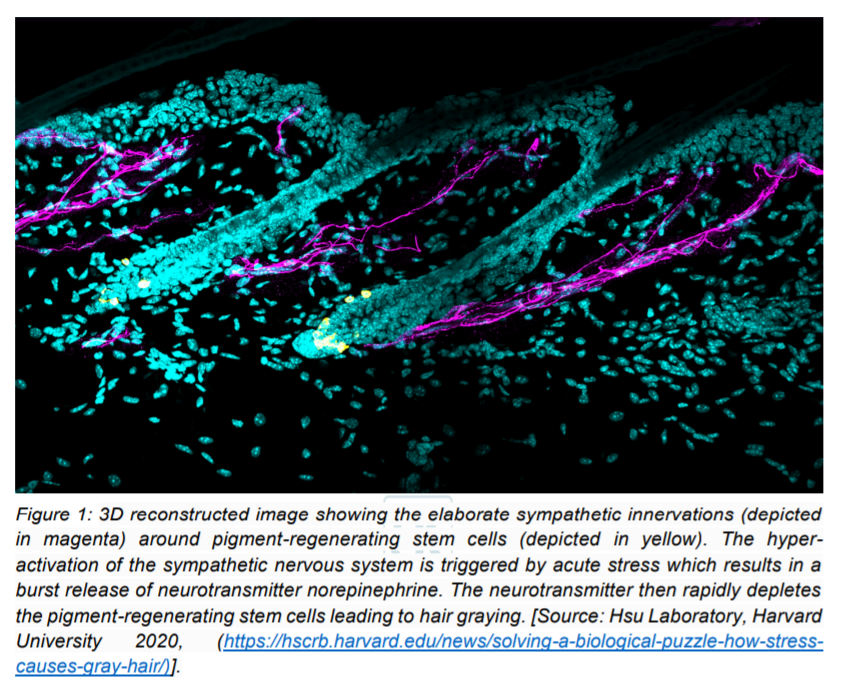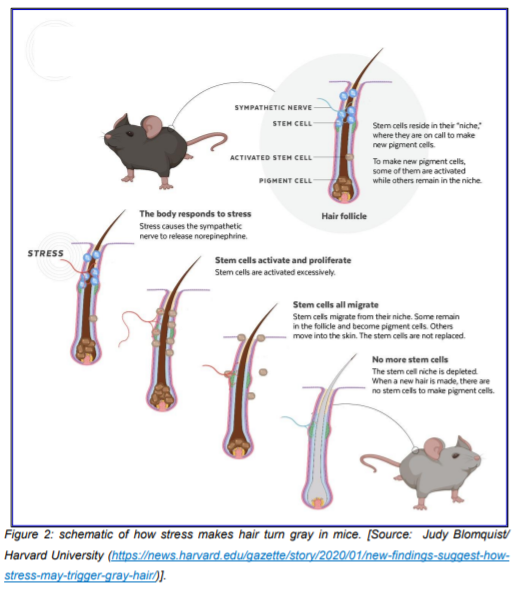Proteomics, Digestive Diseases & Metabolism
June 8, 2020Myocardial complications and COVID-19 infections
June 8, 2020
Abstract
Once considered a taboo, mental health is a trending health topic now days and is considered one of the crucial aspects of good health. Neuroscience and medical advances can be credited for busting the longstanding myths and dogmas associated with brain health. Stress is one of the most common factors that affect the mental well being and has been long associated with graying in human beings, however without any significant medical or scientific proof. Here, we describe this concept of premature aging that has intrigued researchers for a long time. A recent study provided evidence in favor of the stress based theory of aging. Mouse was used as a model organism to study how acute stress leads to hair graying. A combination of denervation, chemogenetics, cell ablation, adrenalectomy and knockout of the adrenergic receptor specifically in melanocyte stem cells was used to check potential targets. After eliminating different possibilities it was confirmed that acute stress leads to the activation of the sympathetic nervous system which in turn causes permanent damage to tissue regeneration via non-reversible depletion of melanocyte stem cells (MeSCs) residing in the bulge and hair germ region of the follicle which are mainly responsible for the regeneration of pigmented hair.
Keywords: Stress; graying; aging; melanocyte stem cells (MeSCs); sympathetic nervous system
Introduction
According to The World Health Organization (WHO) human health is defined as “a state of complete physical, mental and social well-being and not merely the absence of disease or infirmity”. A lay man often confuses good health with only a fit disease free body although in reality good health also refers to a healthy mind. Mental health has become a trending topic and has been garnering attention from all over the world. Earlier people shied away from discussing their mental health issues and rightly so because it was one of the most frequently misunderstood aspects of human health. Neuroscience and medical advances can be credited for busting the longstanding myths and dogmas associated with brain health. Today we are equipped to understand neuronal diseases much better and the complexity of the human brain has been largely decoded. We have developed an understanding of neuronal development, neurodegeneration and neuroregeneration. There are various neurodegenerative diseases and brain associated disorders which have been the focus of scientific and medical research. Several adverse conditions of the brain have been medically acknowledged and find widespread attention from not only a disease point of view but also as an important aspect of human personality.
Eminent personalities and celebrities have also positively highlighted the importance of mental health via anecdotes and social media posts. Thanks to the awareness raised, people are now realizing that visiting a psychologist and psychiatrist does not necessarily mean a person is mentally ill. However when we talk about the mental health issues one of the first words that draw our attention is stress. Stress is a word we frequently use in our everyday life, sometimes without even realizing the actual medical meaning of the term.
Biologically speaking stress is an emotional, mental or a physical factor that causes bodily or mental tension. Various external environmental, social and psychological factors can lead to stress. Similarly internal factors such as disease or surgeries are also responsible for stress. Hectic work schedules and unhealthy lifestyles are the major reasons which cause stress. We have often heard people complaining that stress causes graying of hair and there are several anecdotes cited as examples. However so far, no medical research had ever confirmed the theory with conviction that whether stress causes graying or not.
For the very first time a group of Harvard researchers have given scientific evidence in favor of the theory and discovered the underlying mechanism. In the current article we shall briefly discuss the salient findings of their research work which was recently published in the journal Nature (1).
Stress and graying: the neuroscience behind the theory
It is well known that stress has an overall impact on the human body comprising various tissues, however graying hair is one of the most obvious and visible changes that are associated with the same. The hair follicle comprises three stages i.e. growth, degeneration and rest which are also known as anagen, catagen and telogen phases respectively. Hair follicle stem cells (HFSCs) and melanocyte stem cells (MeSCs) residing in the bulge and hair germ region of the follicle are mainly responsible for the regeneration of pigmented hair. While HFSCs are responsible for the production of new hair, MeSCs are largely responsible for providing the pigment to the newly generated hair follicles via melanocytes (2). Thus melanocyte lineage can be used as a suitable model to investigate how stress and tissue regeneration are interlinked.
Since stress affects the entire body it was challenging for the researchers to narrow down and pinpoint which specific systems were involved. Studies were carried out in mice with black coat color and three different approaches were used to model stress: chronic unpredictable stress, restraint stress and nociception-induced stress (which was achieved through an injection of resiniferatoxin (RTX)) (3). All three procedures led to the formation of white (unpigmented) hair over time but nociception-induced stress produced the most rapid and pronounced effect—many new hair that formed in the next hair cycle after RTX injection became unpigmented. In order to select the target system several theories were proposed and then cross checked for results. The research team previously hypothesized that stress induced immune attack leads to hair graying. To check the involvement of the immune system, RTX was injected into Rag1 mutant mice which lack both B and T cells and into CD11b-DTR mice, in which myeloid lineages had been ablated by diphtheria toxin. RTX injection into these immune-deficient mice still resulted in formation of white hair, thus ruling out the possible involvement of the immune system (1).
All forms of stress are known to increase the levels of corticosterone and noradrenaline in the blood and therefore this hormone became the next target for research. Thus using a combination of denervation, chemogenetics, cell ablation, adrenalectomy and knockout of the adrenergic receptor specifically in melanocyte stem cells it was confirmed that the stress induced loss of melanocyte stem cells is independent of adrenal stress hormones or immune attack (1).
Once the different possibilities were eliminated, researchers narrowed down on the sympathetic nervous system, which is responsible for the body’s fight-or-flight response (4). The sympathetic nerves innervate the melanocyte stem-cell niche and branch out into each hair follicle on the skin. Stress induces the activation of these nerves which in turn release a burst of the neurotransmitter noradrenaline (also known as norepinephrine). This neurotransmitter is rapidly taken up by the nearby pigment-regenerating stem cells. This causes the quiescent melanocyte stem cells to proliferate rapidly, and is followed by their differentiation, migration and permanent depletion from the niche. If the proliferation of melanocyte stem cells can be transiently suppressed, the stress induced hair graying can be prevented. Figure 1 shows the three dimensional reconstructed image depicting the sympathetic innervations around pigment-regenerating stem cells.

The study results clearly show that acute stress triggers neuronal activity that can drive a prompt and permanent loss of somatic stem cells. Once the reservoir of naïve MeSCs is exhausted there is no means of replenishing the pigment generating cells and thus gradually graying becomes an irreversible process. Acute stress triggers beneficial and transient fight-or-flight responses which are critical for the survival of living beings but any factor that can disturb the homeostasis of the body will have negative side effects too. The current study is an example that illustrates that overall physiological state of the organism directly influences the maintenance of somatic stem cells. The results clearly highlight that stress leads to the activation of the sympathetic nervous system which in turn causes permanent damage to tissue regeneration via non-reversible depletion of somatic stem cells. Figure 2 summarizes the concept of how stress triggers graying in mice.

Conclusion and outlook
The current study has clearly established the link between stress and graying and has opened new avenues for further research. As essentially all the organs are innervated by the sympathetic nerves acute stress might possibly affect many different tissues through neuronal signals. The connection between pigment-producing cells and the nervous system has been evolutionarily conserved and several interesting examples are found in nature. For example Cephalopods like octopus, cuttlefish and squid have unique coloration systems that allow them to change color for communication or camouflage. Similarly chromatophores (pigment producing cells) are controlled by neuronal activities which allows rapid changes in color in response to predators or threats (5). Graying is a natural aging process but it is often confused with old age. It is very natural for teenagers and young adults to become conscious about their looks when they notice grey hair. It leads to low self esteem and anxiety which again triggers stress. Thus it is a never ending cycle. Although stress is not the only reason for graying, genetics, disease and other unknown factors are also responsible. However, stress is the simplest and most obvious reason that can be taken into consideration. We cannot completely eliminate stress causing situations around us but can definitely make efforts to improve our mental health and well being. To conclude we would suggest keep worries at bay to avoid growing grey.
References
- Zhang B, et al. (2020) Hyperactivation of sympathetic nerves drives depletion of melanocyte stem cells. Nature 577(7792):676-681.
- Rabbani P, et al. (2011) Coordinated activation of Wnt in epithelial and melanocyte stem cells initiates pigmented hair regeneration. Cell 145(6):941-955.
- Baral P, et al. (2018) Nociceptor sensory neurons suppress neutrophil and γδ T cell responses in bacterial lung infections and lethal pneumonia. Nature medicine 24(4):417.
- Ulrich-Lai YM & Herman JP (2009) Neural regulation of endocrine and autonomic stress responses. Nature reviews neuroscience 10(6):397-409.
- Reed CM (1995) The ultrastructure and innervation of muscles controlling chromatophore expansion in the squid, Loligo vulgaris. Cell and tissue research 282(3):503-512.